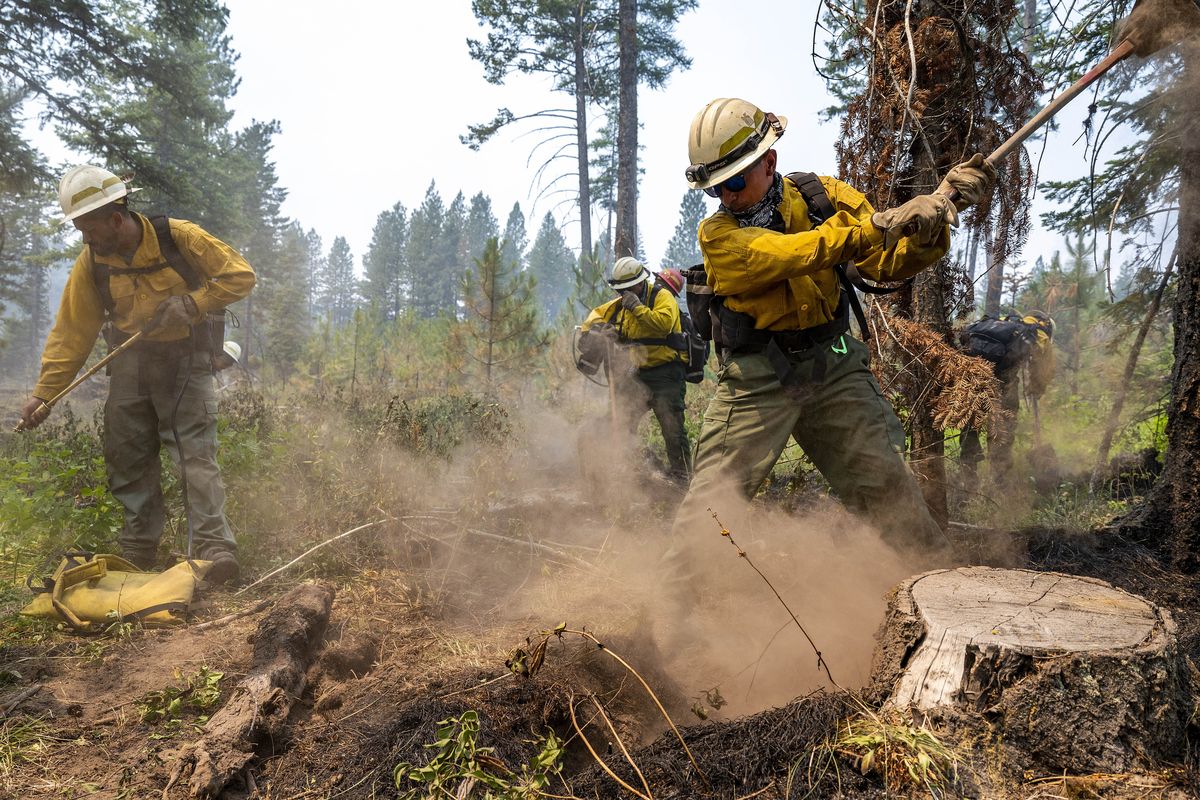‘Unprecedented conditions’ lead to resource shortages for firefighting agencies

Local fire agencies have put out the call for more support staff as they continue to battle what officials have called an unusually intense wildfire season amid a shortage of workers.
The Idaho Department of Lands needs more drivers and warehouse workers. Applicants could have any experience in warehousing or distributing to be considered, the release said.
“It takes a lot of people to meet the demand to keep everything supplied, from water to food, hoses, pumps, anything a firefighter could need,” said Scott Phillips, policy and communications chief at the IDL. “This is crucial because with all the resources in short supply, if we can’t keep firefighters equipped, they can’t do their job.”
Centered at fire caches, the employees will find themselves doing everything from stocking shelves with water to inflating used firehoses, Phillips said.
Support for crews also includes packaging food and creating mobile kitchens for firefighters who have to camp at the sites, said Rich Elliott, the Deputy Fire Chief of Kittitas Valley Fire and Rescue, who is currently part of the team managing the 11,000-acre Red Apple fire in Chelan County.
And those supplies are in high demand, he said.
“We need to understand there are large local fire agencies stocking supplies for fires you would normally see in mid- to late August,” Elliott said.
Dan Lennon, the logistics section chief for the Type 3 incident management team battling the Red Apple fire, said each local agency has its own set of supplies, but agencies often share with each other.
“Everybody has their own warehouse, but we do try to have an interagency cache center,” he said. “When things are escalating so much, those really get tapped.”
Because the supply chain is managed by separate local, state and federal levels, the process can delay both supplies and information, Elliott said.
Elliott noticed this at the Red Apple fire, he said, which threatened enough structures that local crews asked for a regional Type 2 incident management team, who are equipped to battle a fire of this size.
“There were literally none left anywhere in the northwest,” Elliott said. “They ended up getting a Type 1 management team, which is a national asset from Southern California, and at a pretty significant cost.”
Also, by the time the team gets to the fire, Elliott said it will likely be more stable than what they normally handle. Still, having an out-of-state team means local crews have time to recover, he said.
For employees at fire cache sites, lack of staff often doesn’t pose the biggest challenge, said Thomas Kyle-Milward, wildfire communications manager for the Washington State Department of Natural Resources. The state fire cache in Tumwater has eight employees, for example.
Instead, employees and crews often have to anticipate which supplies firefighters will need. They also have to ensure those supplies are stocked at the moment crews need it, Kyle-Milward said.
“Fire season is overwhelming no matter how much prep work you do at the end of the day,” Kyle-Milward said. “We’re not at a point where there is a shortage in staffing or supplies, but it’s about navigating an industry where supplies aren’t always available right when you need them.”
Transportation plays a role in this, too, Lennon said. Drivers will take supply vans with thousands of feet of hosing or full water tanks that are not easy to transfer, he said.
While it doesn’t mean a fire will go unattended, timing these supplies can result in a “juggling act,” Kyle-Milward said.
“Ideally, it’s seamless,” Elliott said. “In reality, when you have the federal, the state and local governments, sometimes those interests aren’t aligned.”
Funding also remains an issue, Kyle-Milward said. This year the Washington State Legislature passed a bill that expanded funding for the Department of Natural Resources, according to the bill report.
Kyle-Milward said this bill will allow for the hiring of at least 100 new firefighters next year and will help cover other costs of worsening fire seasons.
“We’re not hiring full-time staff based on one weird year, unless it’s a trend we can track over several years,” Kyle-Milward said. “This is a new normal that I don’t think folks, not just at the DNR but Washingtonians in general, have not even begun to adjust to. If you look just at acres burned, in the tens of thousands you can see just how bad wildfire seasons are escalating.”
At a federal level, President Joe Biden also promised to expand funding to raise firefighter wages and facilitate year-round firefighting efforts.
Phillips said those interested in a position with the Idaho Department of Lands would work 12-hour shifts at $16.76 per hour six days a week, with options for overtime. Applicants should send their resumes to careers@idl.idaho.gov as soon as possible.
“We are seeing conditions one would expect in mid- to late August. These are unprecedented conditions,” Phillips said. “There’s a demand for fire resources that we’ve never seen before.”